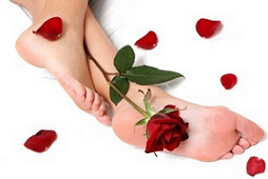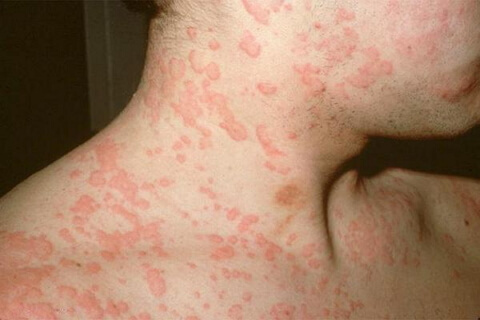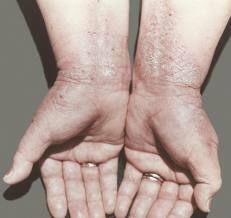Allergy on the legs
 Allergy on the legs is a manifestation of the body's allergic reaction to the penetration of the allergen. Itching and skin rashes on the feet and legs are often symptoms of allergy, the culprits of which may be diseases of the hematopoietic system, internal organs and fungal diseases.
Allergy on the legs is a manifestation of the body's allergic reaction to the penetration of the allergen. Itching and skin rashes on the feet and legs are often symptoms of allergy, the culprits of which may be diseases of the hematopoietic system, internal organs and fungal diseases.
Allergy to the feet is often provoked by a fungus, Trichophy tonrubrum, which is fond of moisture and heat, which develops under favorable conditions created by poor footwear with insufficient conditioning. When the feet are affected by this kind of fungus, an intolerable skin itch is observed, which, however, can not be combed, since a damaged bacterial infection with ease can penetrate the bacterial infection, which will only aggravate the situation. Also in the composition of poor-quality footwear can include some elements of skin substitutes, which can cause the development of an allergic reaction. Although in some cases even high-quality, one-hundred percent leather footwear causes the development of allergies( more often peeling, rash and itching), which is due to the peculiarities of the technology of skin treatment. And by the way, socks are recommended to be worn out of 100% cotton.
Skin manifestations on the legs are not always caused by fungal diseases. This symptomatology can be caused by any allergic reactions of the body, and since allergens in nature are just a huge amount, it is difficult to identify the only one that caused allergy on the legs. First of all, the cause of the allergy should be sought in the chemicals used( washing, cleaning, etc.), medicines and in food.
Often, an allergy to the legs is the result of close human contact with animals and such products of their vital functions as saliva, dander and the fur of dogs and cats;Feathers and fluff of poultry, etc. If it was accurately established that the allergy on the legs arises from contact with any domestic pets, their content is best abandoned. When this option is unacceptable, for example, if a child is very accustomed to a pet, you should clean the apartment daily, prevent the pet from entering the bedroom and get a good air filter.
Allergy to the legs in a child very often develops after switching to artificial feeding and manifests as scaly, itchy red spots. In this case, the development of an allergic reaction was triggered by a malnutrition. In the case of the appearance of this symptomatology, it is not worth taking a decision on the child's further nutrition. Concerning the further ration of the kid it is best to consult a pediatrician.
Often, allergies on the legs are caused by food allergies, and in particular foods such as chocolate, fish, eggs, strawberries, citrus fruits, nuts. Children often experience an increased sensitivity of the body to cow's milk.
Allergy to the feet is often provoked by microscopic dust mites, living in soft furniture, toys, pillows, blankets and curtains. In the case of a developed allergic reaction to household( household) ticks, it is necessary to replace all bedding and down pillows with synthetic ones, and treat the room itself with anti-malignant( acaricidal) sprays.
Allergy to the legs must necessarily be treated, however, due to the fact that it is necessary to establish a provoking allergen before the treatment, and this process is not fast, the reception of antihistamines is shown to alleviate the symptoms. Although they do not cure allergies, they will soothe constantly annoying itching, prevent possible combing and, accordingly, the development of bacterial infection.
In order to protect against infection, and if it is available to reduce symptoms, certain procedures must be followed with the legs. Every time after showering or washing your feet, you should carefully wipe between your fingers, for this you can even use a hairdryer. To wash your feet is recommended in cold or cool water, which not only prevents the development of fungal diseases, but will also serve as a kind of tempering the body.
In some cases alternating drying and moistening of the feet is recommended. The fungus itself and the allergy caused by it on the legs to such procedures are very bad. The procedure is as follows: it is necessary to moisten a piece of gauze with any astringent solution and apply it to the legs for a while, after which, when the gauze dries, they should be wiped dry. Also to get rid of the fungus, antifungal creams like "Lotrimin" and "Tinactin" are good. In addition to creams, all kinds of powders, which are applied to dry feet and sprinkled inside the shoes, are quite effective. Usually within two weeks, in the case of a systematic recurrence of this procedure, allergy symptoms on the legs are passed.
Socks should be changed as often as possible, because if they are constantly wet or dirty, they will not be able to defeat the fungus and accordingly the allergy will fail. After rain or snow, shoes should be dried well. To destroy the microbes that live inside the shoe, you can sprinkle the antifungal powder "Tolnafteet" inside.
If your feet are sweating heavily, you should try changing cotton socks to acrylics, as they can absorb much more moisture. If the allergy on the legs does not go away, you can try to abandon colored socks, as some dyes are very strong allergens.
Allergic manifestations on the feet often cause dry skin. To get rid of this, it is necessary to use moisturizers with increased content of vitamin E. Urea is another excellent moisturizer. Putting on your feet twice a day lotion with urea completely rid of the dryness of your feet.



